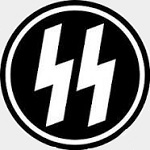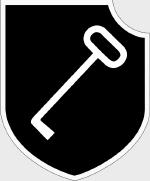Dragon DRR62005 German Sd. Kfz. 171 PzKpfw V Panther Ausf. G Medium Tank - 1.SS-Panzer Division "LSSAH", France, 1944 (1:72 Scale)
"If the tank succeeds, then victory follows."
- Major-General Heinz Guderian, "Achtung Panzer!"
 In many respects, the Panther tank was viewed as the finest armored fighting vehicle of the Second World War. Based in large part upon the Soviet's highly successful T-34 medium tank, the PzKpfw V Ausfuhrung G was built by several manufacturers including MAN, Daimler-Benz and MNH. Mounting a fearsome 7.5cm KwK42 L/70 cannon and two 7.92mm MG34 machineguns, the Panther Ausf. G represented the third and certainly the most impressive installment in the Panther series.
In many respects, the Panther tank was viewed as the finest armored fighting vehicle of the Second World War. Based in large part upon the Soviet's highly successful T-34 medium tank, the PzKpfw V Ausfuhrung G was built by several manufacturers including MAN, Daimler-Benz and MNH. Mounting a fearsome 7.5cm KwK42 L/70 cannon and two 7.92mm MG34 machineguns, the Panther Ausf. G represented the third and certainly the most impressive installment in the Panther series.
The weight of the production model was increased to 43 tons from the original plans for a 35 ton tank. Hitler had personally reviewed the final designs and insisted on an increase in the thickness of the frontal armor - the front glacis plate was increased from 60mm to 80mm and the turret front plate was increased from 80mm to 100mm.
Once the problems caused by the vulnerability of the engine and the transmission were solved, it proved to be a very effective fighting vehicle. The crew was made up of five members: driver, radio operator (who also fired the bow machine gun), gunner, loader, and commander.
This particular 1:72 scale replica was attached to the 1.SS-Panzer Division "LSSAH", then deployed to France during the summer of 1944.
Sold Out!
Dimensions:
Length: 4-3/4-inches
Width: 2-inches
Release Date: August 2009
 Historical Account: "Normandiefront" - SS-Panzer Division Leibstandarte Adolf Hitler (LSSAH) was formed on March 17th, 1933, by Josef "Sepp" Dietrich, Hitler's bodyguard, on the order of der Fuhrer who wanted a full-time armed force that was completely loyal to him. It was attached to Heeresgruppe Sud during the invasion of Poland and later took part in the invasion of France and the Low Countries. For the most part LAH was held in reserve although it was employed against retreating British troops trapped at Dunkirk. After the British capitulation, it was attached to XIV Armeekorps during the second and final phase of the invasion of France.
Historical Account: "Normandiefront" - SS-Panzer Division Leibstandarte Adolf Hitler (LSSAH) was formed on March 17th, 1933, by Josef "Sepp" Dietrich, Hitler's bodyguard, on the order of der Fuhrer who wanted a full-time armed force that was completely loyal to him. It was attached to Heeresgruppe Sud during the invasion of Poland and later took part in the invasion of France and the Low Countries. For the most part LAH was held in reserve although it was employed against retreating British troops trapped at Dunkirk. After the British capitulation, it was attached to XIV Armeekorps during the second and final phase of the invasion of France.
Following the armistice, LAH was upgraded to a brigade and began training for the planned invasion of Britain (Operation Seelowe). When the invasion was cancelled, LAH was transferred to Romania for the Balkan invasion.
It fought its way through Yugoslavia and Greece chasing Allied troops to Kalamata, where they were evacuated by sea to Crete. LAH was attached to Heeresgruppe Sud during the initial stages of Operation Barbarossa, seeing action at Kiev and again at the Black Sea port of Rostov. It was transferred to France for refitting in 1942 and was upgraded again, this time to a Panzergrenadier Division. It returned to the Eastern front the following year, fighting at Kharkov and then at Kursk during Operation Zitadelle. After Kursk, LAH was sent to Italy to perform anti-partisan duties but was soon returned to the Eastern front, this time as a full-fledged Panzer Division. Following the debacle at Kamenets-Podolsk, it was sent to France for rest and refit.
LAH fought in Normandy following the Allied invasion and saw action at Caen, Falaise, and Aachen as it fell back on the German frontier. It participated in the Ardennes counteroffensive (Operation "Wacht am Rhein<") where it was attached to I SS Panzerkorps. Later on, LAH was sent back to the Eastern front to help break the siege of Budapest (Unternehmen Margarethe). Afterwards, it was transferred to Austria where it surrendered to American troops at war's end.





 Panther G
Panther G 


